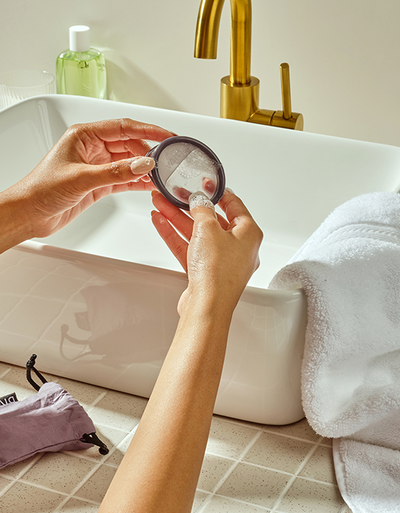
In this article /

Tampons Débrouillardise & Papyrus
Si vous aviez vécu avant les années 1900 et que vous veniez d'avoir vos règles, vous pourriez fabriquer une serviette menstruelle à partir de... essentiellement, tout ce que vous pourriez trouver. Si vous avez de la chance, c'est de la laine ou du coton doux, même si la mousse aurait peut-être été plus absorbante. Il serait maintenu en place entre les jambes et changé fréquemment pour éviter les infections et l'inconfort général.Le jour le plus lourd, si vous viviez dans l’Égypte ancienne, vous pourriez utiliser du papyrus ramolli comme tampon, qui fonctionnait de la même manière mais n’était peut-être pas aussi confortable qu’un tampon moderne. Le papyrus « ramolli » était encore assez rugueux et probablement pas très lisse à insérer dans votre vagin.
Superstitions et tabous
En plus de l'inconfort physique des temps anciens, la gestion des superstitions et des tabous importants (dont beaucoup existent encore aujourd'hui) aurait pu également faire partie de votre journée.Les règles étaient/sont considérées comme honteuses et impures, et le contact avec d’autres personnes n’était pas acceptable. Certaines personnes pensaient que l’on pouvait gâcher la nourriture ou faire dépérir les plantes. En conséquence, les menstruations étaient souvent isolées jusqu’à la fin de leurs règles.
Même s'ils étaient considérés comme « impurs », les bains n'étaient plus fréquents. Il était déconseillé de se laver pendant vos règles, de peur que cela ne soit nocif pour les autres ou ne vous rende stérile. Au lieu de cela, vous avez peut-être utilisé un chiffon humide avec de l'eau ou du vinaigre, changé de vêtements plus fréquemment ou utilisé des parfums ou des herbes pour masquer les odeurs.
Coussinets, ceintures et bloomers
Les options limitées et la croyance omniprésente selon laquelle les menstruations étaient honteuses et impures ont dominé pendant de nombreux siècles.Au début des années 1900, dans certaines régions du monde, des « ceintures sanitaires » munies de boucles ont été inventées pour maintenir les serviettes hygiéniques en place. Mary Beatrice Davidson Kenner a été la première à inventer la ceinture menstruelle, qui a finalement ouvert la voie à la serviette autocollante. La ceinture était réglable et attachée à une poche à serviette résistante à l'humidité, pour maintenir votre serviette en tissu en place.

Les premières serviettes et tampons fabriqués commercialement
Ce n'est qu'après la Première Guerre mondiale, avec le développement des pansements chirurgicaux destinés à la guerre, que la première compresse commerciale a été conçue et fabriquée.L'un des premiers pads que vous avez peut-être utilisé est Sfag-Na-Kins . La sphaigne est capable d'absorber 20 fois son propre poids sec en fluides et contient des propriétés antibactériennes. La mousse a été traitée puis enveloppée dans de la gaze pour créer ce produit jetable.

Les serviettes hygiéniques en mousse de sphaigne des archives de l'histoire des femmes américaines du Smithsonian .
Quand les tampons ont-ils été inventés ?
Même s'ils n'ont pas existé longtemps, les Sfag-Na-Kins ont ouvert la voie à de futurs progrès. Les fabricants de tampons qui existent encore aujourd'hui ont repris ce modèle et ont fabriqué un tampon similaire en pâte de bois recouvert de gaze. La publicité les a aidés à gagner du terrain et le marché des produits « d’hygiène féminine » a été propulsé vers l’avant.Les premiers brevets pour les tampons menstruels ont été déposés à la fin des années 1920 et au début des années 1930. Earl Haas a créé le premier design introduit avec succès sur le marché. Sa conception comprenait le premier applicateur en carton. Mais c'est Gertrude Tendrich qui a finalement acheté le brevet et fondé la première marque commerciale de tampons.
Alors que les tampons corrigeaient les problèmes d’irritation vaginale provoqués par les serviettes hygiéniques, les gens trouvaient les tampons « inconvenants » et, dans les années 1970 et au début des années 1990, ils prenaient conscience du syndrome de choc toxique. On craignait également que les tampons n’influencent la « virginité ».
Au cours du XXe siècle, les produits menstruels jetables tels que nous les connaissons aujourd’hui, y compris les tampons, sont devenus largement disponibles et abordables. Bien qu’ils ne soient pas les plus respectueux de l’environnement, ils offrent beaucoup plus de commodité et de confort.
La première coupe menstruelle et le retour aux réutilisables
La première coupe menstruelle, en caoutchouc, a été inventée par Leona Chalmers . Bien qu’inventé en 1937, le caoutchouc se raréfie à cause de la Seconde Guerre mondiale et la production s’arrête.Entre 1950 et 1970, Chalmers a réessayé, en s'associant à une plus grande entreprise de produits d'époque et leur coupe menstruelle, la Tassette, est arrivée sur le marché. Cette nouvelle version de la coupe menstruelle n’a cependant pas duré longtemps. Les femmes étaient encore une fois gênées d’insérer directement la coupe menstruelle dans leur vagin et affirmaient qu’elle était trop inconfortable à porter. Pour contrer cela, Chalmers a créé une coupe menstruelle plus douce, plus proche de la DIVA Cup.
Aujourd’hui, nous disposons d’une grande variété de produits d’époque. Alors que nous recherchons des pratiques plus durables, nous adoptons les coupes menstruelles réutilisables, les tampons de coton lavables et les sous-vêtements menstruels. Il est passionnant de réfléchir à la manière dont l’entretien du vélo continuera d’évoluer.
Bien que je sois reconnaissante d’avoir mes règles aujourd’hui avec de nombreuses options disponibles, je choisis mon DIVA Disc et mes sous-vêtements menstruels. Et soyez rassuré par le fait que si l'apocalypse arrive, je devrais être bien préparé, du moins en ce qui concerne mes règles.









